|
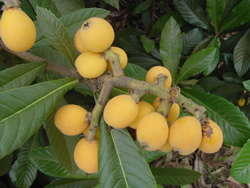 Trees
are loaded with beautiful yellow-orange fruit. A mild winter has
blessed us with an abundance of fruit in such quantities that
every citizen can partake. If you do not have a tree in your yard,
just ask any neighbor who does have a tree to share the bountiful
crop with you. If your neighbor is the greedy type, remind him
that he will soon experience the biggest mess in history when
the wonderful fruit becomes a wondrous, rotting mess beneath the
tree unless you assist birds and mammals such as opossums, racoons,
squirrels and deer in consuming the bounty. Trees
are loaded with beautiful yellow-orange fruit. A mild winter has
blessed us with an abundance of fruit in such quantities that
every citizen can partake. If you do not have a tree in your yard,
just ask any neighbor who does have a tree to share the bountiful
crop with you. If your neighbor is the greedy type, remind him
that he will soon experience the biggest mess in history when
the wonderful fruit becomes a wondrous, rotting mess beneath the
tree unless you assist birds and mammals such as opossums, racoons,
squirrels and deer in consuming the bounty.
This fruit is so abundant and so beautifying, local officials
might be tempted to designate it as San Antonio's tree mascot.
This would not be an appropriate decision since this tree only
produces fruit every decade. The fruitful tree which I am referring
to is the loquat or sometimes known as Chinese plum. People are
really excited because the dark-green, thick?leafed loquat tree
in their backyard which has seldom had fruit on it is now loaded
with colorful fruit. The loquat is an attractive evergreen tree
that is adapted to much of Central, East West and South Texas.
Winter tree 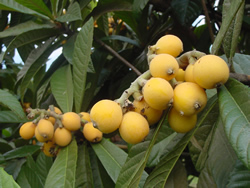 damage
is a problem in the northern portions of Texas that experience
winter temperatures below 10 degrees F. Fruit are set in the fall
and mature in the spring. Winter temperatures below 25 degrees
F. usually destroy the fruit, so consistent fruit production is
limited to the extreme southern portions of the state. When you
have a loquat crop, you can be assured that you had a mild winter.
Most people are skeptical about eating the fruit figuring that
such an unplanned fruit crop is too-good-to-be-true so it must
be poisonous. Loquat fruit is perfectly wonderful to eat fresh.
Wait until the fruit colors (from greenish to deep yellow or orange)
and softens to a firm squeeze. Then peel the fruit or eat peeling
and all for extra roughage. Don't chew and swallow the large seeds
unless you really have a roughage deficiency! damage
is a problem in the northern portions of Texas that experience
winter temperatures below 10 degrees F. Fruit are set in the fall
and mature in the spring. Winter temperatures below 25 degrees
F. usually destroy the fruit, so consistent fruit production is
limited to the extreme southern portions of the state. When you
have a loquat crop, you can be assured that you had a mild winter.
Most people are skeptical about eating the fruit figuring that
such an unplanned fruit crop is too-good-to-be-true so it must
be poisonous. Loquat fruit is perfectly wonderful to eat fresh.
Wait until the fruit colors (from greenish to deep yellow or orange)
and softens to a firm squeeze. Then peel the fruit or eat peeling
and all for extra roughage. Don't chew and swallow the large seeds
unless you really have a roughage deficiency!
I realize that producing an abundant fruit crop without doing
any planning (variety selection) or applying pesticides to avoid
wormy fruit is unbelievable. Just consider this year's loquats
as a “manna” crop to, in a small way, compensate for
the horrendous insect populations of Biblical proportions which
Texans will experience this summer. The insect survival and proliferation
is a direct result of the mild winter as is the loquat bloom survival
and fruit production.
Some of you may have never made homemade jam or jelly. You don't
know what 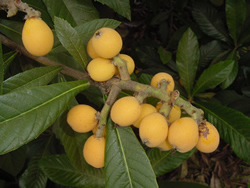 you
are missing! First you remove the skin or peel the loquats by
blanching. Blanch by pouring boiling water over the loquats until
they are covered (floating). Add one-fourth cup of lemon juice
to each quart of water; cook over low heat about 5 minutes, just
until skins loosen. Drain. Cool, peel, and halve and seed the
loquats. you
are missing! First you remove the skin or peel the loquats by
blanching. Blanch by pouring boiling water over the loquats until
they are covered (floating). Add one-fourth cup of lemon juice
to each quart of water; cook over low heat about 5 minutes, just
until skins loosen. Drain. Cool, peel, and halve and seed the
loquats.
The seed is highly toxic so cut off the fruit from the seed before
eating fresh or cooking to extract juice. With that said, if anyone has ever roasted and eaten loquat seed, please telephone me (or have your nearest surviving relative telephone me) on Saturday or Sunday from 12:00 pm to 2:00 p.m. on KLUP Radio (930AM THE ANSWER) at: 210-308-8867 or 866-308-8867 toll free. I would swear that year’s ago someone told me that the seed could be roasted!-!-
Some surefire, safe ways to consume loquats are:
LOQUAT JAM
5 cups loquats
1 box fruit pectin
7 cups sugar
Wash fruit well. Cut off both ends and remove seeds. Place fruit
in a saucepan (which is no more than one-third full with fruit
and juice added) with a small amount of water. Cook slowly and
mash with a potato masher occasionally until well done. Stir occasionally
to prevent sticking.
Add pectin such as Sure-Jell or Certo to the fruit and stir
well. Let the mixture come to a rolling boil stirring occasionally
to prevent sticking. Add sugar and boil to a rolling boil for
1 minute.
LOQUAT JELLY
Wash loquats and remove seeds. Place in saucepan and add enough
water to barely cover fruit. Cook gently for 10 to 15 minutes,
then strain through jelly bag or four layers of cheese cloth.
(For greater yield of juice, twist the two ends of the bag in
opposite direction until most of the juice is extracted. Then,
strain through clean cheese cloth or jelly bag, but do not squeeze
or press.) Use three cups juice to two cups sugar (this makes
a tart jelly). Measure sugar and set aside. Measure juice and
put into a saucepan (which is no more than one-third full with
juice added), stirring in fruit pectin such as Sure-Jell or Certo.
Bring this mixture to a full boil over high heat, stirring constantly.
At once, stir in sugar. Stir and bring to a full rolling boil
(a boil that cannot be stirred down) and boil hard 1 minute stirring
constantly. Remove from heat. Skim off foam with large metal spoon.
Immediately ladle or pour boiling hot into jelly glasses or jars
leaving one-half inch space at top of grasses, one-eighth inch
space at top of jars. Seal with hot paraffin or with lids and
screw bands. Let jelly stand to cool.
If you are concerned about too much sugar in jams and jelly
and want to make some sugar-free loquat delights, order some
Pomona's Pectin. Pomona's Pectin jells without sugar; it will
jell water. Instructions come with the product. Equal artificial
sweetener can be added after cooking as a substitute for sugar.
For more information about this product, see:
http://plantanswers.com/Recipes/sugarless.html
LOQUAT WINE
One Gallon of Loquat wine
4 pounds of loquats
7 pints of water
2 1/4 pounds of sugar
½ teaspoon of pectic enzyme
1 teaspoon yeast nutrient
1/16 teaspoon of potassium meta-bisulfite
1 package of champagne wine yeast
Strip the fruit off the stems and separate out any moldy or obviously
bad fruit. Mash the loquats and strain through a nylon bag into
the primary fermenting container. Add all the other ingredients
except the yeast. Tie off the nylon bag with the crushed fruit
and put it in also. After 24 hours add the yeast. Cover the primary
container and stir the must daily. In 6 days, squeeze the nylon
bag as dry as possible and siphon the juice to a secondary container
(glass jug) and fit an air lock. Check the air lock weekly and
in two months siphon again. Keep checking every 2 months and siphoning
again until clear. Sometimes it takes 6 months or a year. Then
bottle and enjoy!
Regardless of how you use this “manna” fruit from
the loquat trees, enjoy it now. You never know when you might
get another opportunity.
‘Moy Grande’ Loquat
The ‘Moy Grande’ Loquat is the largest fruited loquat ever sold. It was brought to the U.S. from China by Dr. Ying Doon Moy (see: http://plantanswers.com/heroes/YingDoonMoy.html) in 1998. In 2009, Dr. Ying Doon Moy (called “Mr. Moy”), 80, was enlisted by the Mercer Arboretum near Houston to breed vegetation that would thrive in Houston’s extreme climate. It was in the spring of 2010 that the large fruit was observed by Jerry Parsons and Larry Stein. The fruit is at least twice as large as common loquat fruit. The fruit is much meatier and contains much more juice than a standard loquat. The leaves are much larger and more ornamental than the standard loquat.
The loquat is difficult to root from greenwood cuttings so most plants are produced from seed. The seedlings of the ‘Moy Grande’ loquat require 5-7 years of juvenile (non-fruiting) growth before harvest can begin. During these juvenile years, the plant is used as an evergreen ornamental. Tree height is variable, ranging anywhere from 10 to 20 feet high and 10 feet wide so give the tree space when planting. Generally, unless a loquat is well established, trees are in the shorter range. The fruit itself has a soft, fuzzy exterior comparable to an apricot in size and color, but not in shape. The loquat is teardrop or pear shaped and generally is not larger than 1 inch long – the ‘Moy Grande’ loquat is two to three times that large.
The loquat fruit is generally eaten as is in most cultures. However, it has a relatively high pectin content and can be a valuable addition to jam, jelly or chutney. Some find the taste slightly acidic, but the acidity is diminished if the fruit is eaten when completely ripe. Loquats taste exotic, a cross between a passion fruit and a guava. Their sweetness makes them a perfect substitute for more calorie-rich desserts.
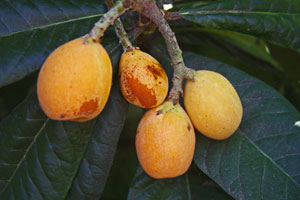
1. 'Moy Grande' loquat compared to standard
fruit in the center of the cluster.
|
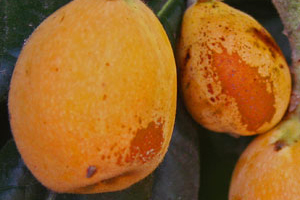
2. Comparison of 'Moy Grande' loquat (left)
to standard size loquat (top right)
|
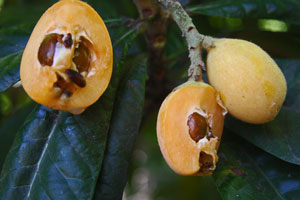
3. Seed of 'Moy Grande' loquat (left) compared
to seed of smaller, standard sized loquat (right)
|
|
|



